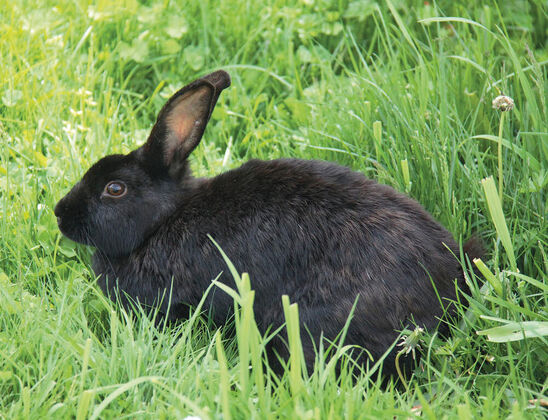Solutions sought as city contends with feral rabbits
By Benny Westcott
Of The New Era
A feral-rabbit issue has plagued Sweet Home and the surrounding area since late last year, but this month it’s worsened by leaps and bounds — or hops, you could say.
On Thursday, May 5, local Lisa Stoke and her daughter saw at least four adult and 10 baby domesticated rabbits at Sunnyside Park.
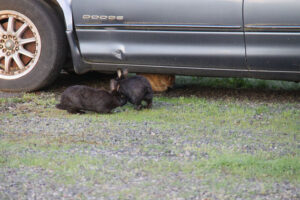
On the same day, park host Mark Hermansen contacted Sweet Home resident Kathy Cozby to ask what to do with a family of rabbits, one mother and seven babies, that had been dropped off in the day-use area and then had moved into the restroom. Cozby said Hermansen called her because she’d taken in a cat that had been dropped off at the park a few years earlier.
It’s also where Allison Griffin, a volunteer for the Lebanon-based Jade Rabbit Small Animal Rescue, found a baby rabbit with a broken rear leg. It had to be euthanized by Dr. Scott Oeffner at Sweet Home Veterinary.
These developments come after months of domesticated rabbits running loose in town. On Nov. 22, 2021, Jade Rabbit executive director Madeline Landrum photographed five feral rabbits clustered on Kalmia Street and posted the picture on the organization’s Facebook page.
“As I pulled into the neighborhood, there were rabbits darting from house to house everywhere,” she wrote, “It’s absolutely sickening how many there were. My goal would be to start working on this colony to the best of my ability, but the sheer number of rabbits is very disheartening. Even if I saved a couple rabbits a month, they would just reproduce and quadruple in numbers. There’s just not enough homes for all these rabbits.”
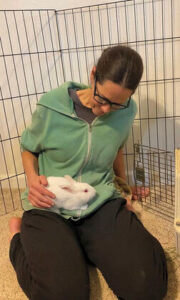
Cozby, who caught one rabbit at Sunnyside, and Stoke, whose daughter grabbed two, discovered for themselves the lack of available homes. Cozby called about 20 rescues and shelters in Salem, Corvallis, Lebanon, Eugene and even as far as Redmond. None had available space.
“I thought that the Sweet Home problem was sort of just a local thing, but when I started calling around to different rescue places and shelters, they said, ‘We are so full of rabbits, we’re maxed out,'” she said.
Stoke also came up short. In the meantime, she’s housing her rabbits in a dog crate while Cozby’s keeping hers until she can find it a home.
Griffin, who’s been involved with animal rescue causes for most of her adult life, said more shelters may have taken the rabbits in the past.
“At times, they had lots of smaller animals and were more willing to adopt them out,” she said. “I have found that a lot of shelters aren’t doing that anymore, and a lot of them don’t even take rabbits.”
She attributed this in part to rabbit hemorrhagic disease virus type 2, or RHDV2, which is highly contagious for domestic rabbits with high mortality rates. It can also infect native rabbit and hare species. According to the Oregon Department of Agriculture, the state’s first known case was identified in a Milwaukie-area feral domestic rabbit colony in March 2021.
“Having these rabbits running all around Sweet Home is a major problem, because they could have that virus and continue to spread and carry it, because they’re not vaccinated,” Griffin said.
Although shelters may lack the space and desire for rabbits, people can still benefit from consulting them. Griffin suggested reaching out to those operations for resources, such as information on places and people to contact. And should someone decide to keep a rabbit, rescue representatives can guide new owners on its health. Shelters can also help find foster homes.
“We would be more than happy to make a post for you on our website and try to get people to help you out,” she said.
Griffin isn’t sure how this local feral-rabbit proliferation came to be.
“We haven’t been able to really root it down to a specific thing,” she said.
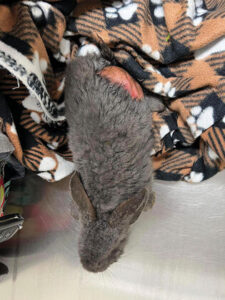
Regarding the Sunnyside situation, Cozby said, “Someone probably accidentally ended up with their rabbit getting pregnant and all these babies and had nowhere to take them. Maybe they thought people would get them or they would be happy in the park. Somebody probably panicked and didn’t know what to do, because it is impossible to find places.”
According to Griffin, the Easter holiday may also be responsible for the influx, when people purchase rabbits, then no longer want them. Others may breed rabbits and decide that the babies are too much work. When attempts to find homes prove unsuccessful, they’re dumped at the park to fend for themselves. Unfortunately, domesticated rabbits aren’t optimally suited for life in the wild.
“People think that it’s part of Mother Nature,” she said. “But you take a white and black or spotty rabbit, or one with really long, floppy ears that can’t keep its ears clean, and you put it outside, they don’t do well wet. They can get really sick. And they don’t do well in heat. They die. And these brightly colored rabbits are easy to spot for a predator.”
Griffin added that they’re easy to spot for humans as well.
“The wild rabbits tend to come in one consistent color, and they look more wild,” she explained. “They don’t look as cute and tiny and fluffy and like a little basketball with a head.
“Domesticated rabbits tend to look like basketballs with heads, and they come in non-useful colors if you want to blend into the background.”
If people see domestic rabbits, Griffin suggested that responsible owners take them in.
“If you can physically house the rabbit in a safe manner, then it’s OK to do that and then reach out to a rescue and offer to foster the rabbit until a home is found,” she said.
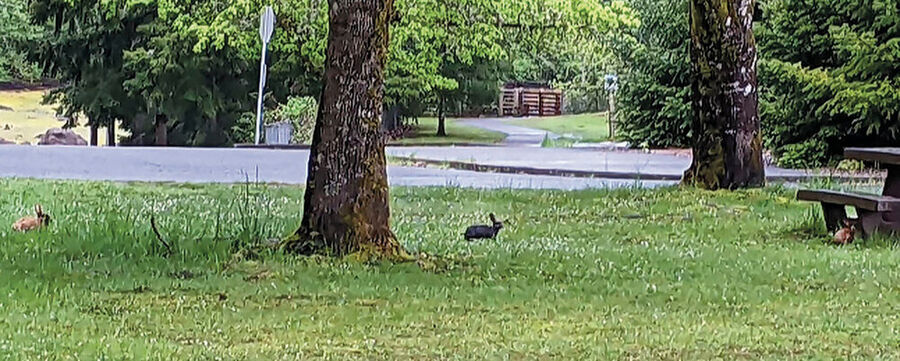
Griffin, who has visions of someday creating a rabbit adoption and education center for the community, emphasized that “Nature does not put the rabbits out there. These domesticated rabbits were not placed out there by nature.
“And if it was people that were responsible for letting the rabbits run wild in the first place, it’s people – all of us – who will be responsible for fixing the problem.
“Sweet Home has an unusual circumstance, and it’s gotten so large that it’s going to take the whole community to deal with it.”




